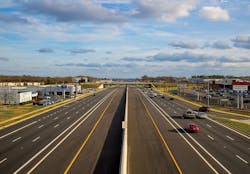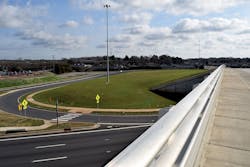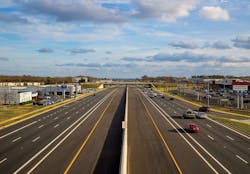Finish what they started
As much of a headache as it may be for one contractor to finish a job started by another, it could be even trickier when the road widening project in question is out of phase and has an uneven intermediate surface course.
That is precisely what Lane Construction Corp. had to work with when they took over the U.S. 74 (Independence Blvd.) widening project in Charlotte, N.C., after the original contractor pulled out of the project in December 2015. Originally a paving subcontractor on the 2.6-mile project when it began in 2013, Lane secured a contract to complete the work in downtown Charlotte through negotiations with the bonding company.
Once Lane landed the role of prime contractor, the North Carolina Department of Transportation (NCDOT) extended the project 3,500 ft and changed the completion date to December 2017. Since the project was completely out of phasing when Lane took over and as a result had a non-uniform intermediate surface course, NCDOT allowed Lane to place a leveling course throughout the project to correct deficiencies and achieve correct cross slopes.
Lane’s successful completion of the arduous work on U.S. 74 earned recognition from the National Asphalt Pavement Association’s (NAPA) 2017 Quality in Construction awards.
Smoothing traffic
In the city of Charlotte, U.S. 74 is the main thoroughfare to access the downtown region of the city from the east. As such, the corridor suffered from major traffic congestion during peak travel times. “During commuter hours, it is slam-packed full,” Tim Gaddy, plant manager for Lane Construction Corp., told Roads & Bridges. “And the fact that we were able to widen it has relieved congestion dramatically in that area.”
The NCDOT plan for U.S. 74 in Charlotte was to widen the corridor to three lanes in both directions and add a bus lane on each side. These lanes were added to the stretch of U.S. 74 from NC 24/27 (Albemarle Road) to east of Wallace Lane.
Part of the work on this route involved removing multiple traffic lights along the corridor. “One of the main ideas for widening the road was to eliminate a lot of stop-and-go’s,” Nicki Beardsley, superintendent for Lane Construction Corp., told Roads & Bridges. “And what we did was construct bridges to go over U.S. 74, and then you had on- and off-ramps as opposed to stop-and-go lights in the intersections.” The main objective of the bridges was to keep the flow of traffic moving on both U.S. 74 and the intersecting roads. Another aim for the elimination of stop-and-go traffic in the area is that it would reduce the carbon footprint in the city.
Lane constructed bridges for adjacent roads to cross over U.S. 74 and added on- and off-ramps. Image: NCDOT
Picking up the pieces
When Lane was still working as the subcontractor on the project, the team had to do full-depth patching of the roadway to repair the existing road and start widening on the outside, opposite of the way the road was designed to be built. “So we started widening the outside after we did the full-depth patching,” Dominic Barilla, former assistant plant manager for Lane Construction Corp., told Roads & Bridges. “And we had an enormous amount of wedging to do on the existing road. So what we had done is when we built the existing wedging, we kept everything an inch low throughout the job so we were able to put a leveling course on.”
Once Lane took the lead on the project, it took about six months to get the out-of-phase work back on track. “One of the biggest struggles was the unknown of finding out all the work that was done on the infrastructure that was covered up already,” Beardsley said. He explained that Lane had to do a lot of investigating into which components of the project had already been completed, which had been completed incorrectly and which elements were not finished at all. Infrastructure work such as storm drain structures were sometimes in place, but some were found to be out of place or buried.
In the end, a lot of the work already completed by the original prime had to be redone. “The state had already paid to have a lot of that work done, and we had to go back and redo it because it was not up to par,” Beardsley added.
When Lane took over the project, work on the corridor had already been going on for a year and a half. As a result of the additional construction timeline along the roadway, many businesses along the route were impacted for a longer period of time as the roadwork limited access to the business’ driveways.
Due to heavy traffic volumes in the area, all of Lane’s paving work was performed at night. The final surface was placed using two paving crews. During the last five months of the job, multiple crews worked together in order to meet the December completion date. Two crews paving in tandem improved joint construction, reduced the number of lane closures and minimized inconvenience to the traveling public.
U.S. 74 going into downtown Charlotte was widened to three lanes plus a bus lane in both directions. Image: Lane Construction Corp.
Big finish
The total asphalt laid down on the project amounted to approximately 237,972 tons, 80,500 tons of which was recycled asphalt pavement. The asphalt mix types applied on the project included 25-mm Superpave at 6 in. thick for the base; 9.5-mm Superpave at 1 in. thick for the leveling; 19-mm Superpave at 4 in. thick for the binder; and 9.5-mm Superpave at 3 in. thick for the surface.
Lane averaged approximately 500-600 tons of asphalt laid down per day, though came closer to 800 tons per day when they hit the surface lift. For the testing process at the two different asphalt plants for the project, full samples were tested at increments of every 750 tons, with close to 300 samples taken. The transporting distance from the plant to the jobsite was approximately 15 miles from each plant, with trucks coming around every 45 minutes.
The paving train included a Roadtec RP 195 track paver with an Eagle screed on the back; Sakai 880 rollers for compaction; a Roadtec Shuttle Buggy 1500 and 2500; and a Cat AP655F paver. About 90% of the mix was put down with the Roadtec paver. “Everything was kept an inch low because of the way we had to basket weave it when [the original contractor] had the job,” Barilla said. “So once we did all the wedging and got it up to grade, everything was kept an inch low.” For compaction, the required density was 92%. Lane ended up averaging 94% on the base mixes, 92.4% on the intermediate courses and 92.8% on the surface mixes.
The average MRI achieved on the project ranged from about 48 to 62. “With the way the job was built, the DOT didn’t think we were going to obtain ride, [but] we had no problem with obtaining ride on it,” Barilla said.
The team at Lane partially attributes their success on completing the otherwise tumultuous U.S. 74 project to a cooperative relationship with NCDOT. “In order for us to obtain the ride we needed and the final quality on this, the DOT was very workable with us about keeping it an inch low and coming through there with a leveling course to help us with our ride,” Barilla said.
The final product achieved for the asphalt paving work on U.S. 74 is what earned Lane recognition from NAPA. “The goal of the asphalt industry is to build high-quality asphalt pavements for the traveling public,” said Dan Gallagher of Gallagher Asphalt Corp., 2017 NAPA Chairman. “With the U.S. 74 in Charlotte project, Lane Construction gave commuters a smooth pavement, with a great density score, that provided needed traffic relief. Their commitment to excellence earned them a 2017 Quality in Construction award.”


